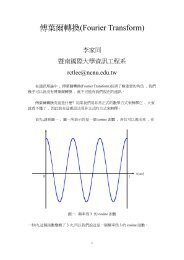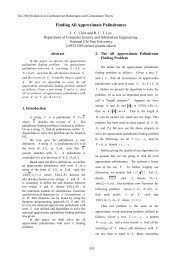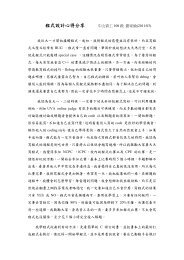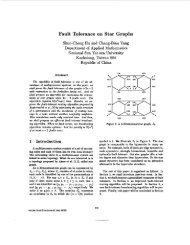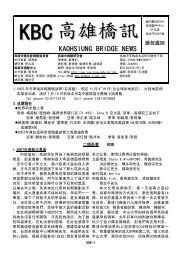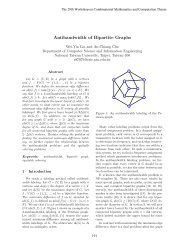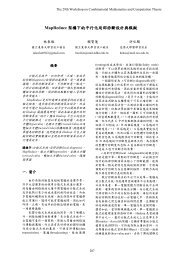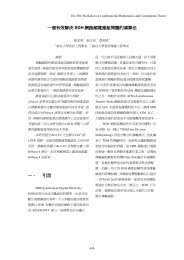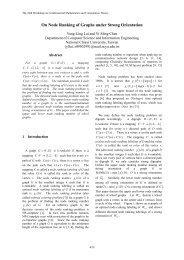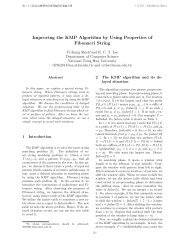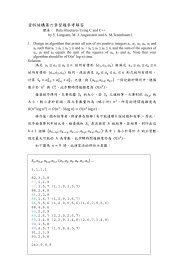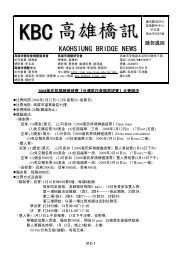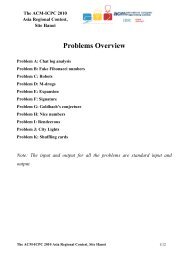The Weighted All-Pairs-Shortest-Path-Length Problem on Two ...
The Weighted All-Pairs-Shortest-Path-Length Problem on Two ...
The Weighted All-Pairs-Shortest-Path-Length Problem on Two ...
You also want an ePaper? Increase the reach of your titles
YUMPU automatically turns print PDFs into web optimized ePapers that Google loves.
<str<strong>on</strong>g>The</str<strong>on</strong>g> 25th Workshop <strong>on</strong> Combinatorial Mathematics and Computati<strong>on</strong> <str<strong>on</strong>g>The</str<strong>on</strong>g>ory<br />
v = lt(G(q)) and v = rt(G(q)); and let v =<br />
i<br />
lt(G(f)) and<br />
v j<br />
be performed.<br />
k<br />
= rt(G(f)). <str<strong>on</strong>g>The</str<strong>on</strong>g> following codes will<br />
recursively compute L[s, t], and L[t, s], for ,<br />
v t<br />
∈ V(G(q));<br />
recursively compute L[s, t], and L[t, s], for ,<br />
v t<br />
∈ V(G(f));<br />
L[i, j] = L[i, k] + L[k, j];<br />
L[j, i] = L[j, k] + L[k, i];<br />
for each pair of vertices v ≠ v such that v ∈<br />
V(G(q)) – { v , v } and v ∈ V(G(f)) – { v ,<br />
v j<br />
}<br />
i<br />
k<br />
/* If <strong>on</strong>e of V(G(q)) – { v , v } and V(G(f)) –<br />
{ v , v } is empty, then we just skip this loop. */<br />
k<br />
j<br />
L[a, b] = L[a, k] + L[k, b];<br />
L[b, a] = L[b, k] + L[k, a];<br />
endfor<br />
vi<br />
∈ V(G(f)) – { vk<br />
, v<br />
j<br />
}<br />
v v<br />
for each pair of vertices and v such that<br />
a<br />
i<br />
b<br />
k<br />
b<br />
b<br />
k<br />
v s<br />
v s<br />
a<br />
k<br />
vb<br />
/* If V(G(f)) – {<br />
k<br />
,<br />
j<br />
} is empty, then we just<br />
skip this loop. */<br />
L[i, b] = L[i, k] + L[k, b];<br />
L[b, i] = L[b, k] + L[k, i];<br />
endfor<br />
for each pair of vertices v and v such that<br />
∈ V(G(q)) – { vi<br />
, vk<br />
}<br />
/* If V(G(q)) – { vi<br />
, vk<br />
} is empty, then we just<br />
skip this loop. */<br />
L[a, j] = L[a, k] + L[k, j];<br />
L[j, a] = L[j, k] + L[k, a];<br />
endfor<br />
a<br />
j<br />
va<br />
Case 3. z is a P-node<br />
Let q and f be the left child and the right child of z,<br />
respectively, i.e., G(z) = G(q) + G(f). In this case,<br />
lt(G(q)) = lt(G(f)) = vi<br />
and rt(G(q)) = lt(G(f)) = v<br />
j<br />
.<br />
<str<strong>on</strong>g>The</str<strong>on</strong>g> following codes will be performed.<br />
recursively compute L[s, t], and L[t, s], for ,<br />
v t<br />
∈ V(G(q));<br />
L<br />
1<br />
[i, j] = L[i, j];<br />
[j, i] = L[j, i];<br />
L 1<br />
recursively compute L[s, t], and L[t, s], for ,<br />
v t<br />
∈ V(G(f));<br />
L<br />
2<br />
[i, j] = L[i, j];<br />
L 2<br />
[j, i] = L[j, i];<br />
v s<br />
v s<br />
L[i, j] = min{ L1<br />
[i, j], L2<br />
[i, j]};<br />
L[j, i] = min{ [j, i], L [j, i]};<br />
L1<br />
2<br />
2<br />
Lemma 5: Phase I can be d<strong>on</strong>e in O( n ) time.<br />
Proof: To complete Phase I, each pair of vertices<br />
v j<br />
and is examined c<strong>on</strong>stant times and each node of<br />
T(r) is also examined c<strong>on</strong>stant times. This implies<br />
2<br />
that Phase I can be d<strong>on</strong>e in O( n ) time. <br />
3.2 Phase II<br />
It is easy to see that LPNA(u), for each P-node u,<br />
can be obtained by the post-order traversal <strong>on</strong> T and<br />
the time-complexity is linear. Based <strong>on</strong> the<br />
reas<strong>on</strong>ing and the results of so far, Phase II can be<br />
achieved by breadth-first traversal <strong>on</strong> T from the<br />
root r. For each n<strong>on</strong>-top P-node u, assume that f =<br />
LPNA(u) and the terminals of G(u) and G(f) are<br />
< vi<br />
, v<br />
j<br />
> and < vs<br />
, vt<br />
>, respectively. <str<strong>on</strong>g>The</str<strong>on</strong>g><br />
following code will be performed.<br />
if (u ∈ left_descendants(f))<br />
OL[i, j] = L[i, s] + [s, t] + L[t, j];<br />
L 2<br />
L 2<br />
OL[j, i] = L[j, t] + [t, s] + L[s, i];<br />
else /* u ∈ right_descendants(f). */<br />
OL[i, j] = L[i, s] + [s, t] + L[t, j];<br />
OL[j, i] = L[j, t] +<br />
endif<br />
L 1<br />
[t, s] + L[s, i];<br />
L 1<br />
<str<strong>on</strong>g>The</str<strong>on</strong>g> following lemma can be verified easily.<br />
2<br />
Lemma 6: Phase II can be d<strong>on</strong>e in O( n )-time.<br />
3.3 Phase III<br />
This phase will be achieved by depth-first<br />
traversal <strong>on</strong> T from the root r. For each P-node u, let<br />
q and f be the left child and the right child of u,<br />
respectively, i.e., G(u) = G(q) + G(f). In this case,<br />
lt(G(q)) = lt(G(f)) = vi<br />
and rt(G(q)) = lt(G(f)) = v<br />
j<br />
.<br />
<str<strong>on</strong>g>The</str<strong>on</strong>g> following codes will be performed.<br />
for each pair { va<br />
, vb<br />
} ∈ pair_set(u)<br />
docase<br />
case va<br />
, vb<br />
∈ V(G(q))<br />
L[a, b] = min{L[a, b],<br />
L[a, i] + L 2<br />
[i, j] + L[j, b],<br />
L[a, j] + L 2<br />
[j, i] + L[i, b],<br />
L[a, i] + OL[i, j] + L[j, b],<br />
L[a, j] + OL[j, i] + L[i, b]};<br />
L[b, a] = min{L[a, b], L[b, i] + L 2<br />
[i, j]<br />
v i<br />
-359-



